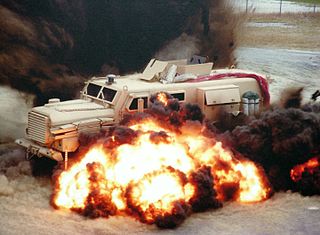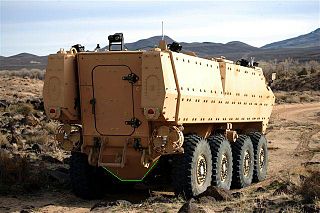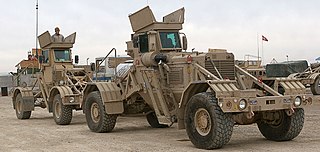
The High Mobility Multipurpose Wheeled Vehicle is a family of light, four-wheel drive, military trucks and utility vehicles produced by AM General. It has largely supplanted the roles previously performed by the original jeep, and others such as the Vietnam War-era M151 Jeep, the M561 "Gama Goat", their M718A1 and M792 ambulance versions, the Commercial Utility Cargo Vehicle, and other light trucks. Primarily used by the United States military, it is also used by numerous other countries and organizations and even in civilian adaptations. The Humvee saw widespread use in the Gulf War of 1991, where it navigated the desert terrain; this usage helped to inspire civilian Hummer versions. The vehicle's original unarmored design was later seen to be inadequate, and was found to be particularly vulnerable to improvised explosive devices in the Iraq War. The U.S. hastily up-armored select models and replaced front-line units with the MRAP. Under the Joint Light Tactical Vehicle (JLTV) program, in 2015 the U.S. Army selected the Oshkosh L-ATV to replace the vehicle in front-line U.S. military service.

The Buffalo is a wheeled mine resistant ambush protected (MRAP) armored military vehicle built by Force Protection, Inc., a division of General Dynamics. It is the largest vehicle in Force Protection's line-up, followed by the Cougar MRAP and the Ocelot light protected patrol vehicle (LPPV).

The Cougar is a mine-resistant ambush-protected (MRAP) and infantry mobility vehicle structured to be resistant to landmines and improvised munitions.

The Snatch Land Rover is a protected patrol vehicle based on the Land Rover Defender 110 chassis. Intended for general patrolling in low-threat areas, the vehicle was developed in 1992 for use in Northern Ireland. It provides a limited degree of small arms protection for occupants and a limited level of protection from Improvised Explosive Devices and off-route mines.

The Cheetah MMPV was a prototype built by the Force Protection, Inc., division of General Dynamics. It was intended as part of Force Protection's armoured military vehicle line-up, which includes the MRAP-class of Buffalo and Cougar vehicles and the Ocelot light protected patrol vehicle (LPPV).

An infantry mobility vehicle (IMV) is a wheeled armored personnel carrier (APC) serving as a military patrol, reconnaissance or security vehicle. Examples include the ATF Dingo, Iveco LMV, Oshkosh M-ATV, AMZ Dzik, AMZ Tur, Mungo ESK, and Bushmaster IMV. This term also applies to Mine-Resistant Ambush Protected (MRAP) vehicles.

Mine-Resistant Ambush Protected is a term for United States military light tactical vehicles produced as part of the MRAP program that are designed specifically to withstand improvised explosive device (IED) attacks and ambushes. The United States Department of Defense MRAP program began in 2007 as a response to the increased threat of IEDs during the Iraq War. From 2007 until 2012, the MRAP program deployed more than 12,000 vehicles in the Iraq War and War in Afghanistan.
The Golan Wheeled Armored Vehicle is a prototype Israeli MRAP infantry mobility vehicle made by the Israeli Rafael Advanced Defense Systems jointly with Protected Vehicles Incorporated.
Plasan is an Israeli-based company that now specializes in survivability solutions for all domains, the design, development and manufacture of protected vehicles, and most recently maneuvering robotics.

The International M1224 MaxxPro MRAP is an armored fighting vehicle designed by American company Navistar International's subsidiary Navistar Defense along with the Israeli Plasan Sasa, who designed and manufactures the vehicle's armor. The vehicle was designed to take part in the US military's Mine Resistant Ambush Protected vehicle program, led by the US Marine Corps, as well as a similar US Army-led Medium Mine Protected Vehicle program.

The V-hull is a type of vehicle armor design used on wheeled armored personnel carriers (APCs), infantry mobility vehicles, infantry fighting vehicles (IFVs) and MRAPs. The design originated in the 1970s with vehicles such as the iconic Casspir used extensively during the South African Border War, Leopard security vehicle used in the Rhodesian Bush War and South African armored vehicle company Land Systems OMCs and Buffels.

The Husky VMMD is a configurable counter-IED MRAP vehicle, developed by South African-based DCD Protected Mobility and American C-IED company Critical Solutions International. Designed for use in route clearance and de-mining operations, the Husky is equipped with technologies to help detect explosives and minimise blast damage.

The Oshkosh M-ATV is a mine-resistant ambush protected (MRAP) vehicle developed by the Oshkosh Corporation for the MRAP All Terrain Vehicle (M-ATV) program. Intended to replace M1114 HMMWVs (Humvee), it is designed to provide the same levels of protection as the larger and heavier previous MRAPs, but with improved mobility.

The Force Protection Ocelot is a British armoured vehicle that replaced the United Kingdom's Snatch Land Rover with British forces. It received the service name Foxhound, in line with the canine names given to other wheeled armored vehicles in current British use such as Mastiff, Wolfhound, and Ridgeback, which are all variants of the Cougar.

Iraqi Light Armored Vehicle or International Light Armored Vehicle is an armored fighting vehicle based on the Cougar and manufactured by Force Protection Industries, BAE Systems and General Dynamics.

Didgori-3 is a Georgian 6×6 MRAP type armored personnel carrier developed by the State Scientific Technical Center "Delta". The Didgori-3 was first displayed during a military parade in 2012 and was proposed as patrol vehicle for deployments.
Burraq is a Mine-Resistant Ambush Protected (MRAP) Vehicle currently being developed by Heavy Industries Taxila (HIT) of Pakistan. It is a 4x4 Protected vehicle based on the chassis of the Isuzu NPS-75 commercial truck so as to reduce the cost and facilitate the delivery of spare parts. In appearance, the Burraq is quite similar to the Wildcat MRAP, developed by the Israel Military Industries (IMI).

Route clearance is a routine part of counter-IED efforts performed by military forces around the world. The purpose of route clearance is to secure an important route and render it for safe transport. This mission relies on the use of Sapper and EOD forces to accomplish this task. Although mines have been used in warfare for years, the rise of IEDs in current conflicts has led to the development of the current route clearance doctrine.

The Oshkosh Alpha is a Mine-Resistant Ambush Protected (MRAP) vehicle created by Oshkosh Corporation together with Protected Vehicles Incorporated (PVI). It is considered as a Category I MRAP vehicle.















